This Homemade Lasagna Al Forno (a.k.a. Lasagna Bolognese) is the ultimate Italian comfort food meal. Rich bolognese sauce, creamy béchamel, and fresh pasta sheets are layered together to create a hearty, scratch-made dish worthy of your holiday dinner table.

Lasagna is one of my favorite Italian dishes. Layer upon layer of creamy, hearty goodness all baked together into one delicious meal. Yum!
I'll be the first to admit that making lasagna bolognese is a bit of a project. But, I believe that is part of what makes this dish so special. And also why I like to go the extra mile and make fresh pasta whenever I make lasagna.
Luckily, the components in this lasagna al forno recipe are make-ahead friendly. So, if you're a good planner, you can whip up a batch of bolognese sauce or béchamel sauce a few days before you want to assemble the lasagna.
A classic lasagna recipe like this one is perfect for special occasions like Christmas or New Year's Eve. Or for chilly winter weekends when you're in the mood to cook something cozy and comforting.
Disclaimer: Some links throughout this post are affiliate links. As an Amazon Associate, I earn from qualifying purchases. You can learn more by visiting my Affiliate Disclosure Page.
Why You'll Love This Recipe
- Homemade Lasagna Noodles- Whenever I take the time to make homemade lasagna, I also like to make fresh pasta. Lasagna is typically made for special occasions so I enjoy making it feel extra special with homemade pasta. Plus, fresh pasta cooks right in the lasagna so it eliminates the step of boiling the noodles before baking.
- Rich & Hearty- Hearty ragù alla bolognese and creamy béchamel are layered between perfectly al dente sheets of fresh lasagna noodles. It's one of the most comforting and satisfying Italian meals you can eat.
- Make-Ahead Friendly- Lasagna can be a bit of a project, especially if you're making each component from scratch. This is why planning ahead and making some of the ingredients beforehand can be such a game changer. Make the pasta dough up to one day ahead of time. Or make the bolognese sauce and béchamel sauce up to a few days ahead for easy assembly the day of.
Ingredient Notes
Here are some notes on key ingredients. For a full list of ingredients, check out the recipe card below.
- Fresh Pasta Dough- Making fresh pasta dough is easier than you think. And it works so well in lasagna because it cooks as the lasagna bakes.
- Ground Beef- I typically use 85-90% lean ground beef. A little beef fat in the bolognese sauce give it flavor and a rich, luscious mouthfeel.
- Soffritto- Classic Italian soffritto consists of onion, carrot, and celery and is the flavor base for many Italian dishes. I prefer to finely mince or grate my soffritto so it melts into the bolognese sauce.
- Milk- While you can use any milk you prefer, I like to use 2% milk. I find 2% milk lends enough fat to give the bolognese sauce and béchamel sauce the creaminess we want without feeling overly heavy.
- White Wine- I prefer to use white wine in my bolognese sauce. It adds a brightness and acidity that cuts through the rich and flavorful beef quite nicely.
- Whole Tomatoes- You can cut or purée the tomatoes before you add them or use a wooden spoon to break them up in the pot as they cook.
- Roux- For the béchamel, creating a roux to thicken the sauce is key. We only want to cook the roux for a few minutes to ensure it doesn't brown.
- Nutmeg- Just a pinch of nutmeg in both the bolognese sauce and the béchamel sauce give each a layer of warmth and add to their depth of flavor.
- Parmesan Cheese- As the only cheese in this lasagna recipe, freshly grated parmesan cheese is a must. Parmesan cheese adds a nutty, tangy note to the lasagna.

Substitutions and Variations
Here are a few ways you can customize this lasagna al forno to fit your diet and taste preferences.
Substitutions
- Fresh Pasta- If making fresh pasta isn't your thing, you can easily substitute it with no-boil lasagna noodles or traditional dried lasagna noodles. For gluten-free lasagna, use your favorite gluten-free lasagna noodles. You'll need about 16 lasagna sheets to make this dish.
- Ground Beef- While I use only ground beef in this recipe, you can feel free to use whatever combination of meat you prefer in your bolognese sauce. I often substitute half of the ground beef with ground turkey. Ground pork or a little pancetta is also common.
- Milk- In both the bolognese sauce and the béchamel sauce, you can use any variety of milk you prefer. Keep in mind, however, that the more fat in the milk, the more tender the beef will be in the bolognese sauce. A higher percent milkfat will also create a creamier béchamel.
- White Wine- Red wine can be substituted for the white wine in the bolognese. You can also use chicken stock or beef stock in place of the wine, but you will not achieve the same depth of flavor.
- Whole Tomatoes- If you prefer your bolognese sauce without large pieces of tomato, feel free to swap the whole tomatoes for crushed or puréed tomatoes. You can also use tomato sauce or tomato paste with a little water.
- Roux- You can make the béchamel sauce using a cornstarch slurry instead of a roux. Simply heat the milk, salt, pepper, and nutmeg over medium-low heat. Then, whisk together 2 tablespoons of cornstarch and 2 tablespoons of water. Slowly pour the cornstarch slurry into the warm milk while whisking the milk continuously. Remove the sauce from the heat once it has thickened.
- Parmesan Cheese- Try replacing the parmesan cheese with pecorino romano cheese, asiago cheese, or mozzarella cheese if preferred.
Variations
- Gluten-Free- For gluten-free lasagna al forno, swap the fresh lasagna noodles for your favorite homemade or store-bought gluten-free lasagna noodles. Additionally, make the béchamel sauce using cornstarch slurry instead of a roux (instructions in the "Substitutions" section above).
- Dairy-Free- For dairy-free lasagna bolognese, skip the milk step entirely in the bolognese sauce and swap the butter for additional olive oil. You'll also want to make a dairy-free béchamel sauce using olive oil and dairy-free milk. Finally, replace the parmesan cheese with dairy-free parmesan cheese or nutritional yeast.
- Egg-Free- Use your favorite egg-free lasagna noodles (homemade or store-bought) to make an egg-free version of this lasagna al forno recipe.
- Vegetarian- If you don't eat meat, replace the ground beef with crumbled tofu, lentils, or mushrooms.
- Spicy- Love all things spicy? Layer in some red pepper flakes when assembling the lasagna for a little heat.
Equipment Notes
Here are some notes on any special equipment I used to make this recipe.
- Pasta Machine- I love my Marcato Atlas 150 Pasta Machine. It was made in Italy and is super easy to use and clean. You can make lasagne as well as fettuccini and spaghetti with it. I've had it for several years now and it's never let me down.
- Dutch Oven- My Dutch oven is my favorite pot to cook just about anything in, but especially beef ragù alla bolognese. Dutch ovens cook food nice and evenly thanks to their ability to retain heat. They're the perfect vessel for a slow-cooked sauce like bolognese. I love my Lodge 6 Quart Enameled Dutch Oven.
How to Make Lasagna al Forno
Here is how to make this baked lasagna bolognese recipe.
For the Lasagna Noodles
Step 1: Create the pasta nest. Make a mound with the flour in a large mixing bowl or on a clean work surface. Then, using the bottom of a clean cup or your hands, create a nest in the center of the flour. Add the eggs, egg yolk, olive oil, and kosher salt to the center of the nest.
Step 2: Make the pasta dough. Using a fork, gently whisk the eggs together in the center of the well, keeping the flour walls intact as best you can. Continue whisking, slowly incorporating some of the flour into the egg mixture, until a thick batter begins to form. At this point, you can use your hands to incorporate the remaining flour.
Step 3: Knead the pasta dough. Knead the dough for approximately 10 minutes or until a smooth and elastic dough ball forms. The dough will be very sticky at first, then it will feel very dry and shaggy. It might not feel like it will come together, but after kneading, all of the flour will be incorporated into a cohesive dough. Wrap the pasta dough tightly in plastic wrap and allow it to rest for 30 minutes at room temperature or in the refrigerator for up to 1 day if making it ahead.
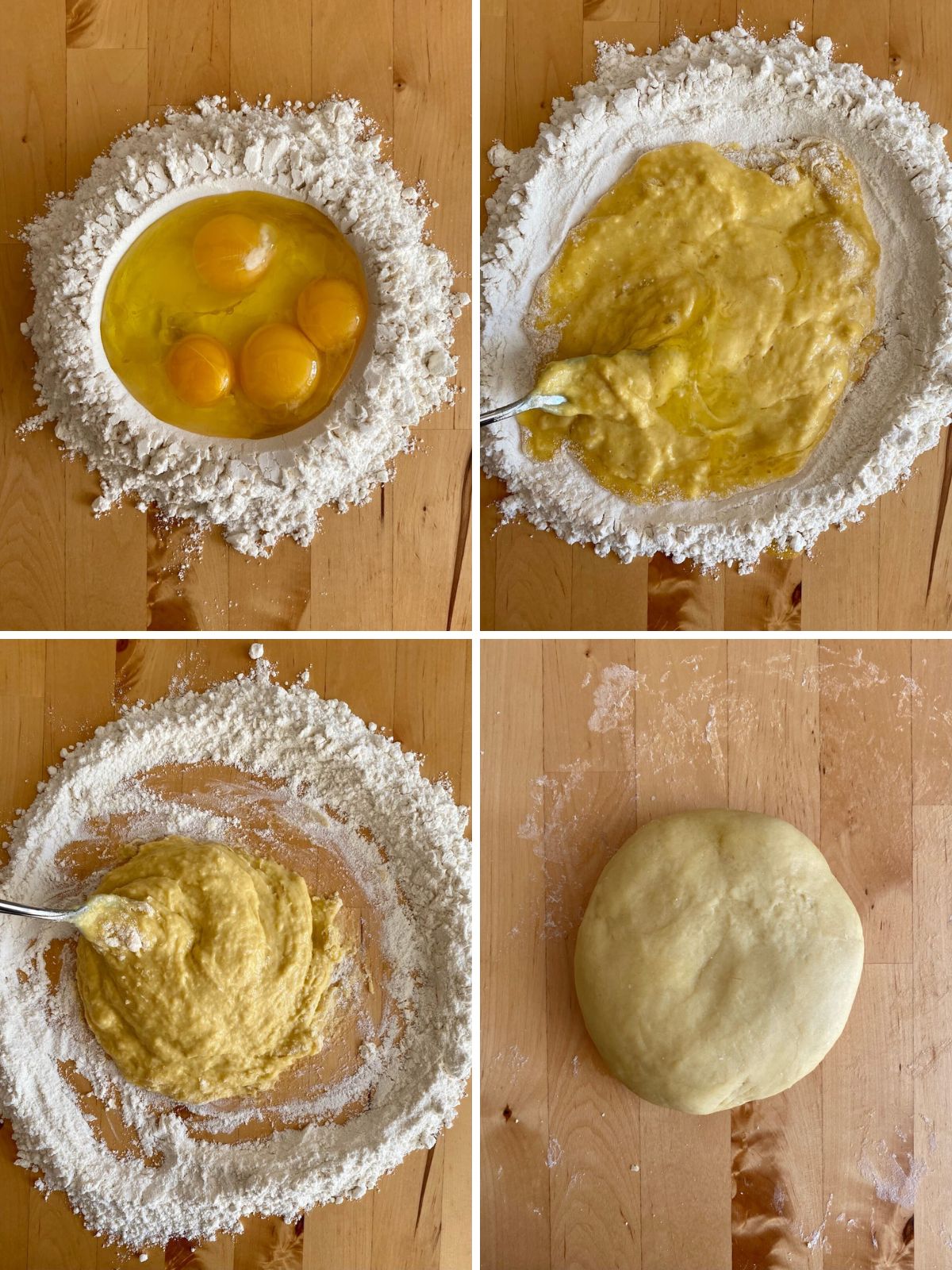
For the Bolognese Sauce
Step 1: Sauté the soffritto. Heat olive oil and butter in a large Dutch oven or pot over medium heat. Once the butter has completely melted, add the onion, carrot, celery, and kosher salt to the pot. Cook until the vegetables have softened, about 5 minutes.
Step 2: Brown the ground beef. Add the ground beef and black pepper to the vegetables, using a wooden spoon to break up the ground beef. Continue crumbling and cooking the meat until it has lost its raw color and most of the liquid has evaporated.
Step 3: Simmer the beef in milk. When the liquid from the meat is mostly gone, pour in the milk. Turn the heat down to low and allow the milk to simmer, stirring frequently, until it has completely evaporated, about 15-20 minutes. Sprinkle in a pinch of nutmeg.
Step 4: Simmer the beef in wine. Once the milk has cooked off, pour in the white wine. Allow the wine to simmer until almost completely evaporated, about 15 minutes. Add in the whole tomatoes, breaking them up with a wooden spoon to release their juices.
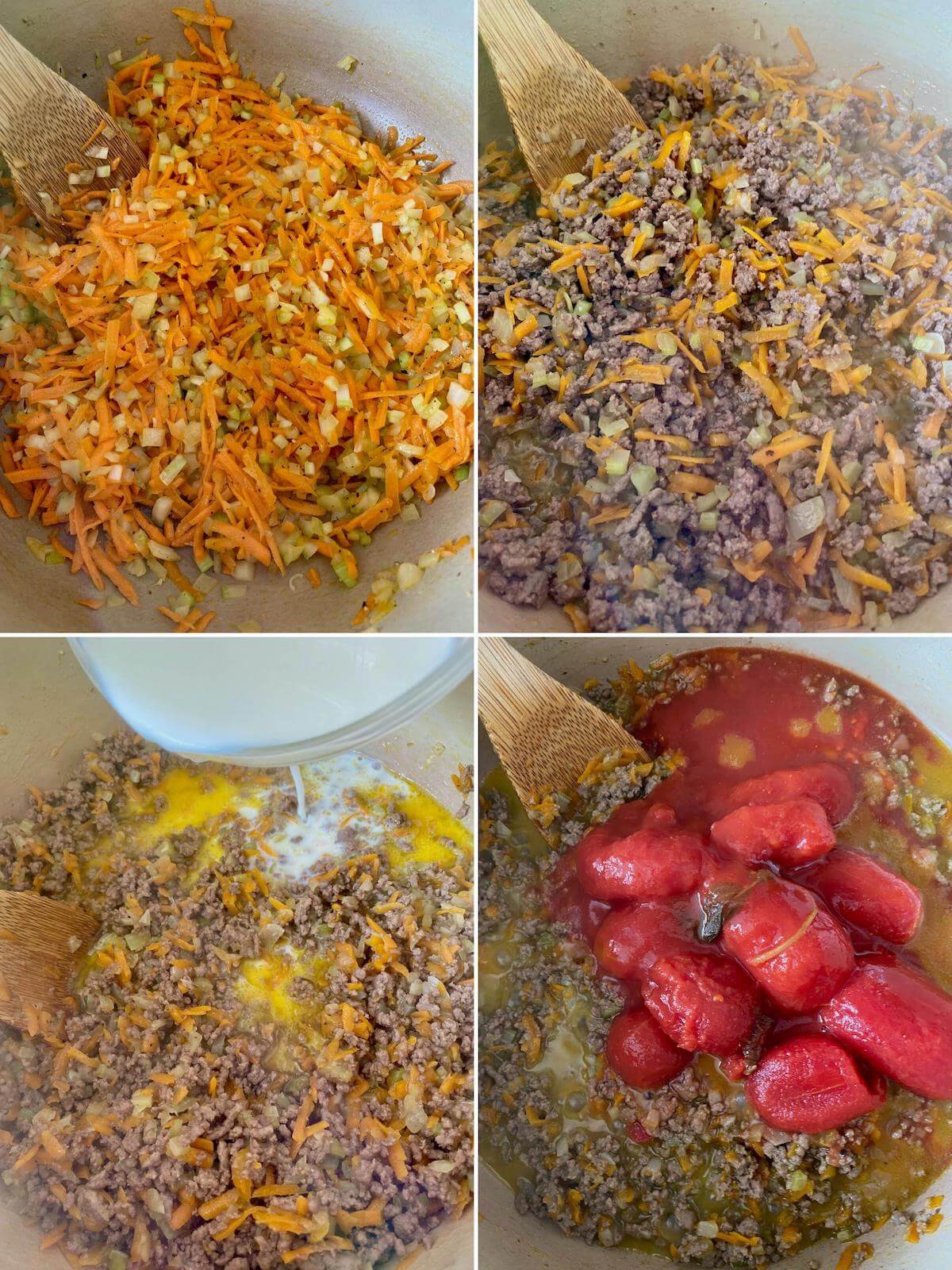
Step 5: Cook the bolognese sauce. Reduce the heat until the sauce is just barely simmering. Cook the sauce, uncovered, for about 3 hours, stirring occasionally. If the sauce appears to be drying out before it's finished, add ½ cup of water. When finished cooking, you want there to be no liquid remaining and for the fat to be separating from the sauce.

For the Béchamel Sauce
Step 1: Cook the roux. Melt the butter over medium-low heat. Once melted, add the flour and whisk together to combine. Cook the roux, whisking continuously, for about 2-3 minutes.
Step 2: Add the milk and seasonings. Slowly pour in the milk, whisking continuously to prevent lumps. Add the kosher salt, black pepper, and nutmeg, and bring the sauce to a gentle simmer. Allow the sauce to simmer until thickened, about 5 minutes. Remove from heat and set aside.

To Assemble
Step 1: Roll out the lasagna noodles. Preheat the oven to 375°F. Dust the pasta dough lightly with flour and cut it into 8 equal pieces. Working with one piece at a time, roll the pasta into lasagna sheets using either a pasta machine or a rolling pin. Each piece of pasta dough will yield two lasagna noodles. Keep the rest of the dough covered with plastic wrap to prevent it from drying out. Note: See recipe card below for more detailed instructions.

Step 2: Assemble the lasagna. Spread ¼ cup of béchamel sauce on the bottom of a 9-inch by 13-inch baking dish. Add a layer of lasagna noodles, overlapping them slightly. I usually do three noodles down the length of the pan, then one noodle across the bottom. Then, add ¼ of the bolognese sauce on top of the noodles, spreading carefully as the sauce will be thick. Pour ¼ of the remaining béchamel sauce on top of the bolognese sauce. Then, sprinkle ¼ of the grated parmesan cheese over the béchamel. Repeat the layers four (4) times in total.
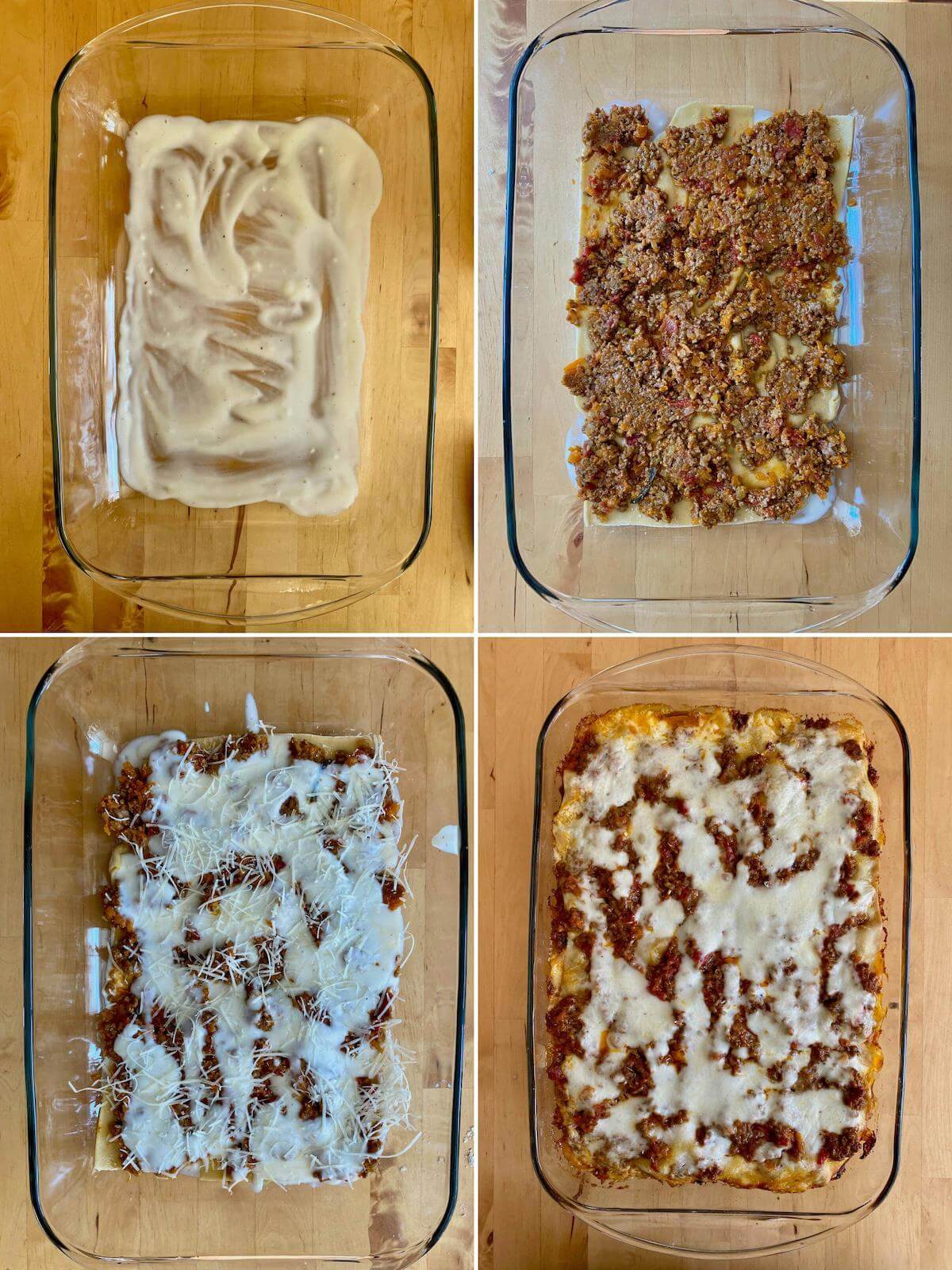
Step 3: Bake the lasagna. Cover the baking dish with aluminum foil and bake at 375°F for 30 minutes. Remove the foil and bake uncovered for an additional 15 minutes. If you want the top to be golden brown, cook the lasagna under the broiler for a few minutes. Allow the lasagna to rest for approximately 20 minutes before serving.
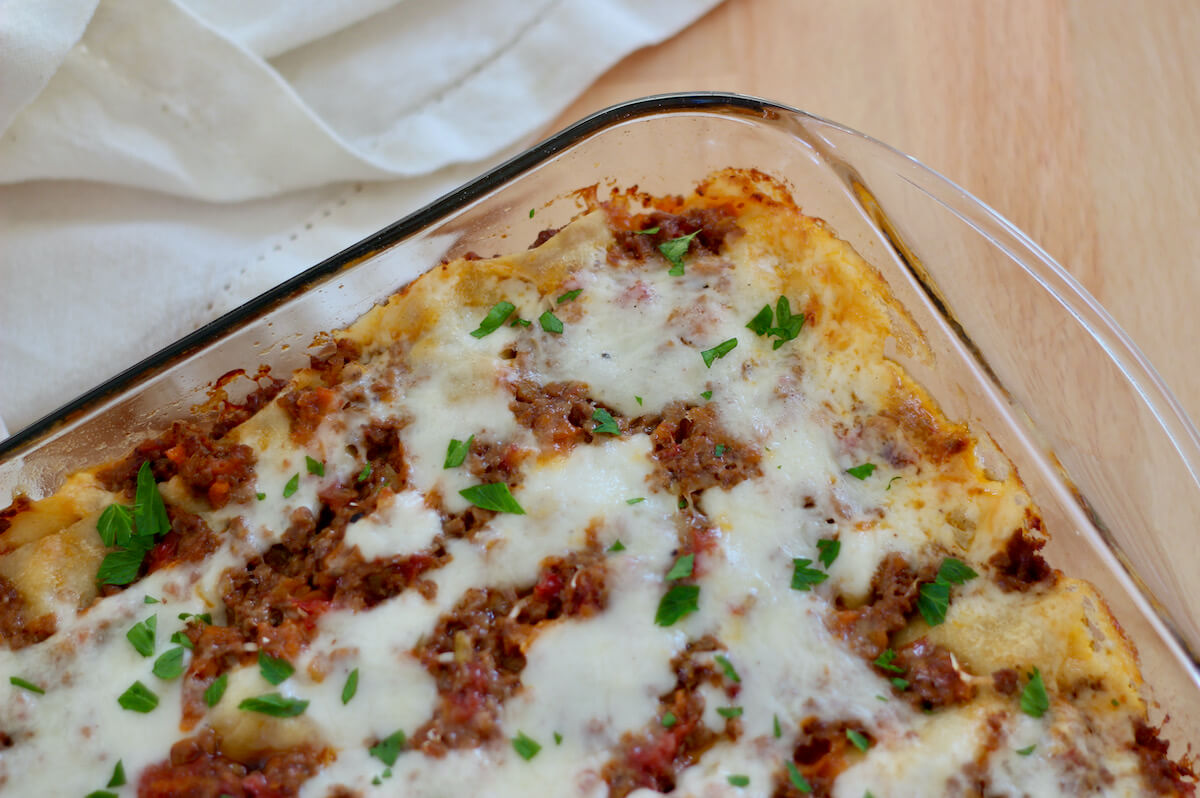
Tips for Success
- Make Ahead- Each component of this lasagna bolognese can be made ahead. For the fresh lasagna pasta sheets, you can make it up to 24 hours in advance and store it in the refrigerator wrapped tightly in plastic wrap. For the bolognese sauce and béchamel sauce, make them up to 5 days ahead of time and store in the refrigerator in an airtight container.
- Don't Boil the Noodles- Fresh lasagna noodles don't need to be boiled before assembling. Cooking the pasta as the lasagna bakes gives you perfectly al dente pasta.
- Mise En Place- Making homemade lasagna from scratch can feel overwhelming if you're not organized. Having ingredients pre-measured before you start cooking can help reduce the stress. Additionally, having all of the ingredients laid out and ready to go makes it so much easier to grab them as you need them.
What to Serve with Lasagna Al Forno
Lasagna bolognese is a hearty dish that doesn't need to be paired with anything. However, if you're looking for a little variety at dinner time, here are a few of my favorite side dishes to serve with lasagna al forno.
- Caesar Salad, Arugula Salad, or Spinach Caprese Salad
- Antipasto
- Burrata Bruschetta
- Grain Salad
- Roasted, Sautéed, or Steamed Vegetables (try my Crispy Roasted Brussels Sprouts, Oven-Roasted Green Beans and Carrots, or Air Fryer Roasted Tomatoes)
- Meatballs
- Garlic Bread or Breadsticks
- Calzone
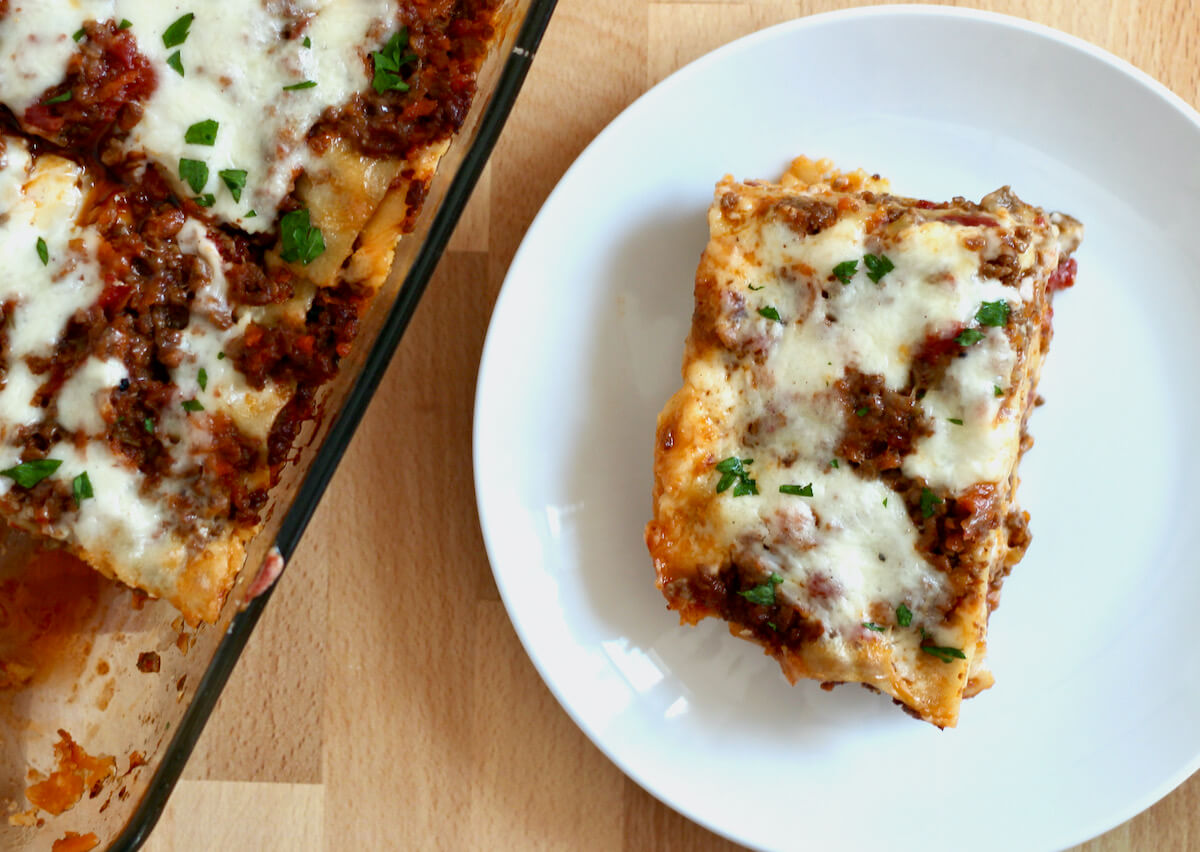
Storage and Reheating
How to Store
- Refrigerator- Cover leftover lasagna bolognese tightly with plastic wrap or store it in an airtight container in the refrigerator for 3-5 days.
- Freezer- Wrap individual pieces of cooled lasagna tightly in plastic wrap, then wrap them again in aluminum foil. Store the wrapped pieces of lasagna in a freezer-safe bag in the freezer for up to 3 months.
How to Reheat
If your leftover lasagna bolognese is frozen, it’s best to allow it to defrost overnight in the refrigerator. Then, allow the lasagna to come to room temperature for about 30 minutes before reheating.
- Oven/Toaster Oven- Preheat the oven to 350°F and place the leftover lasagna in a baking dish. Cover the baking dish with aluminum foil and reheat the lasagna for approximately 30 minutes or until heated through. If the lasagna seems dry before reheating, sprinkle a few teaspoons of water over it.
- Microwave- Place an individual slice of lasagna on a microwave-safe dish and cover with a lid or another dish. Reheat on half-power for 2 minutes. Then, heat on high in 30-second intervals until fully warmed through. If the piece of lasagna is on the larger side, I recommend cutting it in half.
- Air Fryer- Preheat the air fryer to 375°F. Place a slice of lasagna on a piece of aluminum foil inside of the air fryer basket and cover with another piece of aluminum foil. Reheat for 5-10 minutes or until the lasagna is warmed through.
Make Ahead
- Fresh Pasta Dough- Make the pasta dough up to 24 hours in advance. Wrap tightly in plastic wrap and keep refrigerated.
- Bolognese Sauce- Can be made up to 5 days ahead and stored in the refrigerator in an airtight container. If it's too thick to spread, you may need to heat it up a bit before assembling the lasagna.
- Béchamel Sauce- Make and store béchamel sauce in an airtight container up to 5 days in advance.
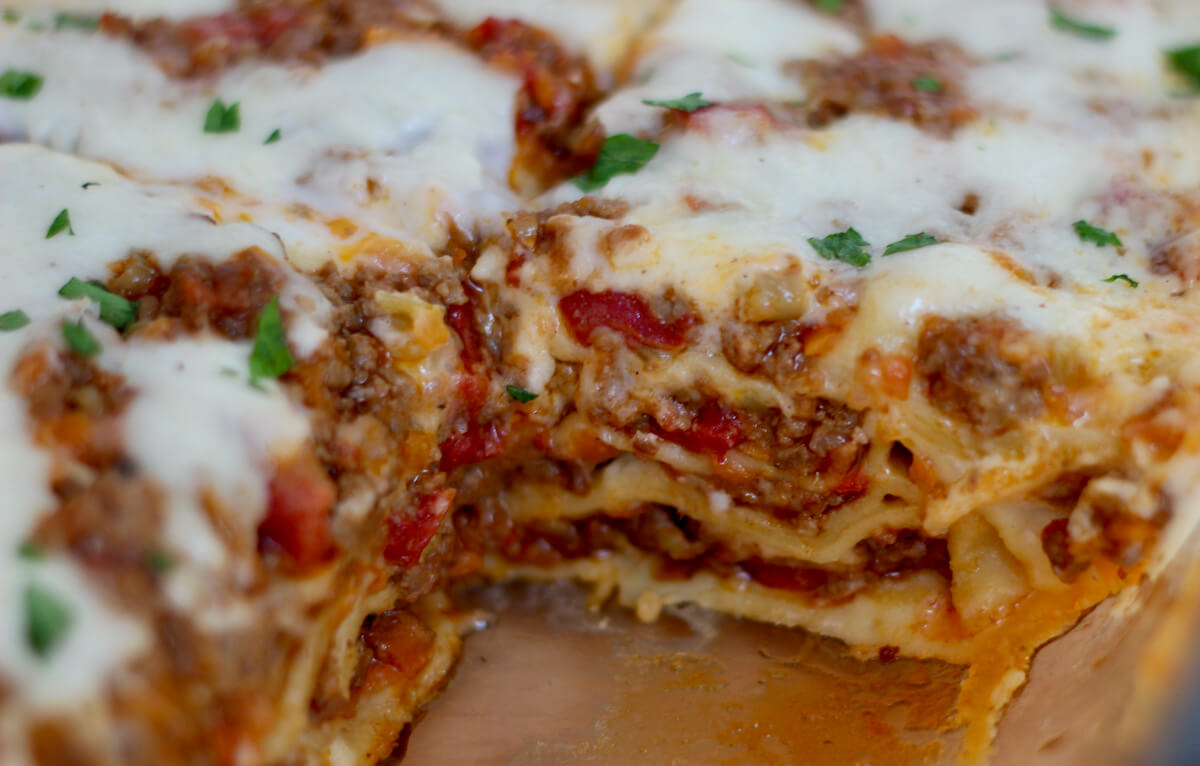
Frequently Asked Questions
Lasagna and lasagna al forno are technically the same dish. However, lasagna al forno is typically made with fresh pasta that is cooked while the lasagna bakes in the oven for a more al dente texture. The term "al forno" means "on fire" in Italian and traditionally refers to dishes baked in a wood-fired oven.
Since we’re using fresh pasta in this recipe, there’s no need to boil the pasta before adding it to the lasagna. The pasta will cook up perfectly as it bakes in the oven. If you opt for traditional, dried lasagna sheets, you will need to boil them before assembling the lasagna.
Yes! In fact, I recommend making the individual components of this dish ahead of time for convenience. You can also assemble the entire lasagna up to one day ahead, but need to boil the fresh lasagna noodles if you do. Boiling the fresh lasagna noodles prevents them from turning mushy as the assembled lasagna sits in the refrigerator.
Let's Connect!
Be sure to leave a comment below if you have any questions. You can also connect with me on Instagram, Facebook, Pinterest, or via email at [email protected].
📖 Recipe
Lasagna Al Forno
Ingredients
For the Pasta
- 2 cups (240 grams) all-purpose flour
- 3 large eggs
- 1 egg yolk
- ½ tablespoon olive oil
- ½ teaspoon kosher salt
For the Bolognese Sauce
- 2 tablespoons olive oil
- 2 tablespoons unsalted butter
- 1 large yellow onion minced
- 2 carrots shredded
- 2 celery stalks finely chopped
- 1 teaspoon kosher salt
- 2 pounds ground beef 85-90% lean
- 1 teaspoon black pepper
- 1 ½ cups 2% milk
- ⅛ teaspoon ground nutmeg
- 1 cup white wine
- 1 28-ounce can whole tomatoes
For the Béchamel Sauce
- 3 tablespoons unsalted butter
- ¼ cup all-purpose flour
- 2 ½ cups 2% milk
- ¼ teaspoon kosher salt
- ⅛ teaspoon black pepper
- ⅛ teaspoon ground nutmeg
For the Lasagna al Forno
- 2 cups Parmesan cheese grated
Instructions
For the Pasta
- Make a mound with the flour in a large mixing bowl or on a clean work surface. Then, using the bottom of a clean cup or your hands, create a nest in the center of the flour. Add the eggs, egg yolk, olive oil, and kosher salt to the center of the nest.2 cups (240 grams) all-purpose flour, 3 large eggs, 1 egg yolk, ½ tablespoon olive oil, ½ teaspoon kosher salt
- Using a fork, gently whisk the eggs together in the center of the well, keeping the flour walls intact as best you can. Continue whisking, slowly incorporating some of the flour into the egg mixture, until a thick batter begins to form. At this point, you can use your hands to incorporate the remaining flour.
- Knead the dough for approximately 10 minutes or until a smooth and elastic dough ball forms. The dough will be very sticky at first, then it will feel very dry and shaggy. It might not feel like it will come together, but after kneading, all of the flour will be incorporated into a cohesive dough. Wrap the pasta dough tightly in plastic wrap and allow it to rest for 30 minutes at room temperature or in the refrigerator for up to 1 day if making it ahead.
For the Bolognese Sauce
- Heat olive oil and butter in a large Dutch oven or pot over medium heat. Once the butter has completely melted, add the onion, carrot, celery, and kosher salt to the pot. Cook until the vegetables have softened, about 5 minutes.2 tablespoons olive oil, 2 tablespoons unsalted butter, 1 large yellow onion, 2 carrots, 2 celery stalks, 1 teaspoon kosher salt
- Add the ground beef and black pepper to the vegetables, using a wooden spoon to break up the ground beef. Continue crumbling and cooking the meat until it has lost its raw color and most of the liquid has evaporated.2 pounds ground beef, 1 teaspoon black pepper
- When the liquid from the meat is mostly gone, pour in the milk. Turn the heat down to low and allow the milk to simmer, stirring frequently, until it has completely evaporated, about 15-20 minutes. Sprinkle in a pinch of nutmeg.1 ½ cups 2% milk, ⅛ teaspoon ground nutmeg
- Once the milk has cooked off, pour in the white wine. Allow the wine to simmer until almost completely evaporated, about 15 minutes. Add in the whole tomatoes, breaking them up with a wooden spoon to release their juices.1 cup white wine, 1 28-ounce can whole tomatoes
- Reduce the heat until the sauce is just barely simmering. Cook the sauce, uncovered, for about 3 hours, stirring occasionally. If the sauce appears to be drying out before it's finished, add ½ cup of water. When finished cooking, you want there to be no liquid remaining and for the fat to be separating from the sauce.
For the Béchamel
- Melt the butter over medium-low heat. Once melted, add the flour and whisk together to combine. Cook the roux, whisking continuously, for about 2-3 minutes.3 tablespoons unsalted butter, ¼ cup all-purpose flour
- Slowly pour in the milk, whisking continuously to prevent lumps. Add the kosher salt, black pepper, and nutmeg, and bring the sauce to a gentle simmer. Allow the sauce to simmer until thickened, about 5 minutes. Remove from heat and set aside.2 ½ cups 2% milk, ¼ teaspoon kosher salt, ⅛ teaspoon black pepper, ⅛ teaspoon ground nutmeg
To Assemble
- Preheat the oven to 375°F. Dust the pasta dough lightly with flour and cut it into 8 equal pieces. Working with one piece at a time, roll the pasta into lasagna sheets using either a pasta machine or a rolling pin. Each piece of pasta dough will yield two lasagna noodles. Keep the rest of the dough covered with plastic wrap to prevent it from drying out.
- If Using a Pasta Machine: Run each piece of pasta dough through the widest setting (usually zero [0]) four times, folding the dough into thirds (like a letter) before each pass-through. Then, run the dough through subsequently smaller settings until you reach setting number five (5). (Note: Settings vary based on the brand of the pasta machine. You should be able to just see the outline of your hand if you hold it under the sheet of pasta.) Keep dusting the dough lightly with flour as needed to prevent sticking. Cut each sheet in half to make two lasagna noodles.
- If Using a Rolling Pin: Lightly dust a work surface with flour and roll each piece of pasta dough out into an approximately 3-inch wide by 20-inch long rectangle. The sheet of pasta should be thin enough to just see the outline of your hand if you hold it underneath it. Cut each sheet in half to make two lasagna noodles.
- Spread ¼ cup of béchamel sauce on the bottom of a 9-inch by 13-inch baking dish. Add a layer of lasagna noodles, overlapping them slightly. I usually do three noodles down the length of the pan, then one noodle across the bottom. Then, add one-quarter of the bolognese sauce on top of the noodles, spreading carefully as the sauce will be thick. Pour one-quarter of the remaining béchamel sauce on top of the bolognese sauce. Then, sprinkle ½ cup of grated parmesan cheese over the béchamel. Repeat the layers four (4) times in total.2 cups Parmesan cheese
- Cover the baking dish with aluminum foil and bake at 375°F for 30 minutes. Remove the foil and bake uncovered for an additional 15 minutes. If you want the top to be golden brown, cook the lasagna under the broiler for a few minutes. Allow the lasagna to rest for approximately 20 minutes before serving.
Notes
- Fresh Pasta Dough- Make the pasta dough up to 24 hours in advance. Wrap tightly in plastic wrap and keep refrigerated.
- Bolognese Sauce- Can be made up to 5 days ahead and stored in the refrigerator in an airtight container. If it's too thick to spread, you may need to heat it up a bit before assembling the lasagna.
- Béchamel Sauce- Make and store béchamel sauce in an airtight container up to 5 days in advance.

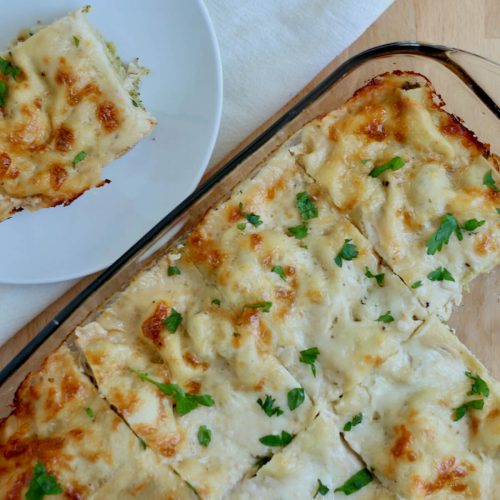
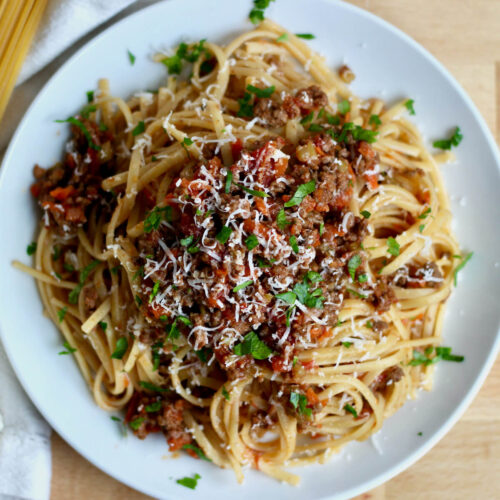

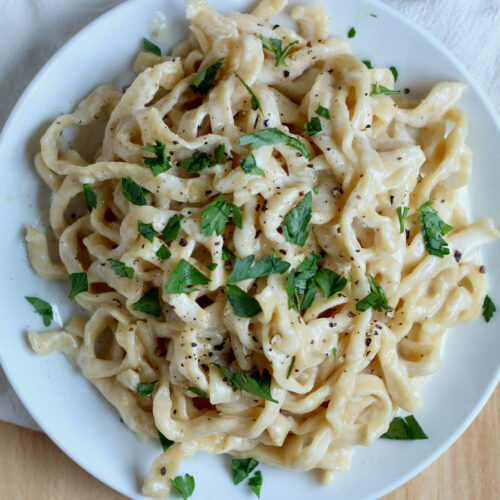
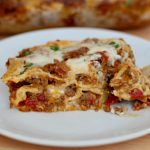
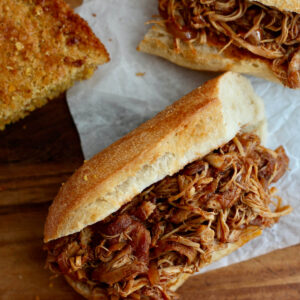
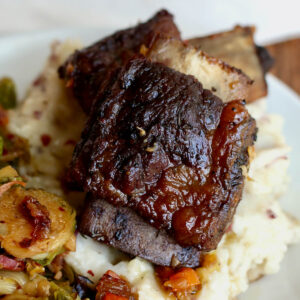
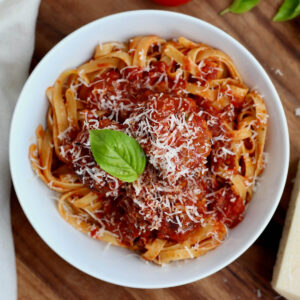

Comments
No Comments